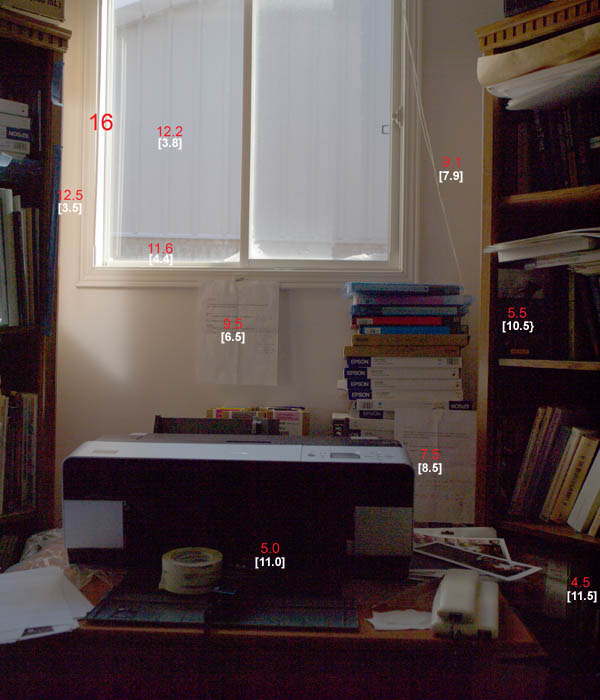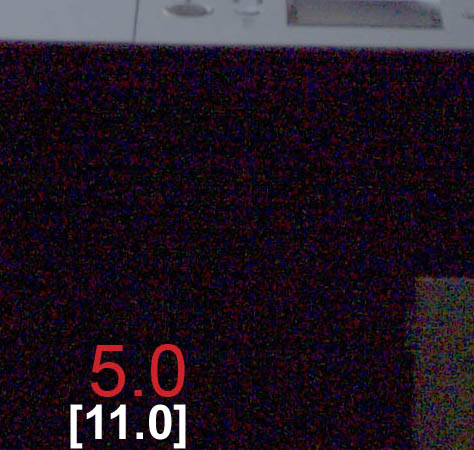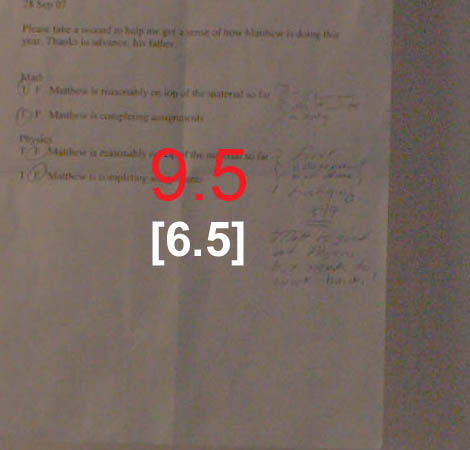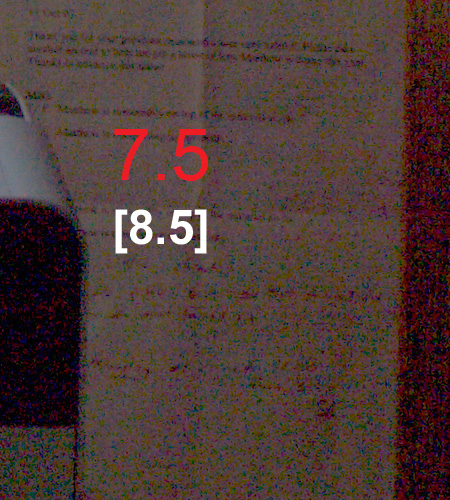The Pentax K20D: a RAW review
Page 3, version 2.2, © 2008 by Dale Cotton, all rights reserved.
Image Quality
IQ 3: Latitude/DR and noise
Much has been made on-line about the supposed improvements of the K20D in these areas. For latitude, the camera has a dynamic range boost function called D-Range available in the Fn button menu. There is also a JPEG-specific HDR processing option. For noise, the idea is that the increased pixel count of the K20D (14.6 mp) over the K10D (10 mp) comes without the expected penalty of increased noise at a given ISO.
Looking into D-Range first, the best I can find is about a 0.4 stop extension of highlight latitude, but with an equivalent loss in shadow latitude in some shots. Another datum is that D-Range cannot be applied to the 100 ISO, which is the camera's slowest ISO setting. I like Joseph Tainter's theory that nothing more is going on here than underexposure combined with a development curve that bulges a bit in the middle zones. (Any suggestions for testing D-Range are welcome.)
To illustrate the HDR (high dynamic range) option I went into the in-camera development menu and converted the RAW file for Fig. 4 into an HDR JPEG. This site is rated G, so I can't show you the result unless you sign a disclaimer saying you accept responsibility for any damage your eyesight may incur from viewing this level of violence, then click here.
I'm sure there is someone somewhere who will appreciate this innovation... (Incidentally: the super-saturation and cyan hue shift are courtesy of the K20D's JPEG processing engine. Enjoy.)
The following seemingly innocuous shot is the method I've been using for years now to extract latitude and noise confessions from reluctant cameras. If you are a gentleman photographer who always works in low to medium contrast light, these results may not interest you; but I, like many others, find that some of the best images have to be wrestled free of their high contrast setting:
This was shot in raw at 100 ISO with manual exposure set to just blow the highlights in the brightest part of the frame – in this case the left window edge. To the human eye the room interior was reasonably well lit, while the left window edge was glaring. To the camera, as we see, everything but that window edge is shrouded in darkness.
Here is the same shot but this time with an extreme curve applied in Photoshop to open things up (although the shadow areas are still nothing like as bright as my eye sees them when I look at this scene):

Fig. 12: Brighter view
The red numbers are EVs (exposure values) metered with my trusty old Seiko Digi-Spot handheld lightmeter. The big 16 is where the highlights blow and all the other EVs are darker. If we subtract the red 5.0 in the maw of my silver and black Epson inkjet from 16 we get 11, which tells us that that part of the scene is 11 stops dimmer than the left window edge. As we would expect, we can see in Fig. 13 there is no detail, only noise at 11 stops:

Fig. 13: Close-up showing 100 ISO noise at 11 stops
More troubling is that noise is noticeably present even at a mere 6.5 stops (but understand that this presentation mercilessly reveals latent noise):

Fig. 14: Close-up showing 100 ISO noise at 6.5 stops
This little noise would not be noticeable without the brightening curve and cleans up easily with a bit of noise reduction, but it portends that high ISO shooting could be a bed of roses (meaning: beware of thorns). Here's a crop at 8.5 stops:

Fig. 15: Close-up showing 100 ISO noise at 8.5 stops
The noise level here constitutes roughly half of all pixels and strongly degrades detail. Still: depending on your usage, you may not need detail in the extreme shadow areas. I'm willing to call the K20D's low ISO latitude at somewhere between 7.5 and 8.5 stops if you are. ;) And, of course, this will degrade at higher ISOs.
Technical confirmation
As I've stated repeatedly this is a pragmatic review. I may know something about how to take a photograph, but am not any kind of expert in engineering matters. It was therefore a great relief to me to have some confirmation that I haven't strayed too far from the course in the results I've reported so far.
Note: The following gets rather technical, so feel free to skip to the next page. In summary: the 14.6 mp K20D has somewhat higher noise levels than its 10 mp predecessor, the K10D, and significantly more shadow (dark readout) noise than the competing 10.1 mp Canon 40D and 12.3 mp Nikon D300. The effect of this is to progressively increase shadow noise as ISO increases, and conversely to diminish exposure latitude (scene dynamic range) as ISO increases.
Each pixel on the sensor chip in a digital camera is essentially a photon (light particle) counter, converting light into electricity. After the shutter is released the strength of the electrical signal from each pixel is measured by further circuitry called an Analog to Digital Convertor or ADC.
A big problem is that neither the sensor nor the ADC is perfectly neutral – trace amounts of electrical current called readout noise is generated by the circuits themselves in spite of every technical effort to eliminate this. The amount is so tiny as to be meaningless when compared to the amount of electrical current the results from taking a picture of a reasonably well-lit scene; but in the deep shadow regions of a well-lit scene or when taking pictures in dim light it becomes impossible to distinguish between readout noise and the current the arises from genuine photon counting. The readout noise appears as brightly but falsely coloured speckles, such as those you can see so abundantly in Fig. 13 above.
To further complicate matters every camera's sensor has a single natural ISO or sensitivity level (which is usually, but not always, the lowest ISO setting on the camera). To allow shooting at high ISOs a third device called the Programmable Gain Amplifier or PGA is used to multiply the current coming from the sensor. Not only does the PGA amplify both the readout noise and the real current from the sensor, it is itself an electronic device and so introduces its own electrical noise, however small an amount.
To combat readout noise each sensor has rows of pixels along the edges that are not exposed to light when a picture is taken. Because they are kept in total blackness any signal they generate can only be readout noise. During the in-camera processing of each picture, the readout noise from the dark pixels at the edge of the sensor are recorded along with the signal from the rest of the sensor. The dark readout signal strength is subtracted from the signal strength of each pixel in the image area to help reduce the amount of noise or false-coloured pixels in the final image.
Each time researchers explore new materials and combinations of materials to make a sensor out of and each time engineers come up with a new sensor design they are always juggling trade-offs between increases in good things like resolution and bit depth against bad things like electrical noise. The 14.6 mp sensor (CMOS technology) at the heart of the K20D was a collaborative effort between the research and design teams of Pentax and Korean chip-making giant Samsung. Undoubtedly, their mandate was to increase pixel count while retaining the standard 23.4 x 15.6 mm sensor size and without increasing noise levels over that found in previous sensors.
Because minimal sensor noise is critical to his area of interest, astrophotographer Gordon Goodsman has designed his own software to test camera noise levels by analysing RAW image file data. When the K20D came out engineer Oleg Volkov and Gordon set out to put it through its paces. Here in Gordon's words are what they came up with:
Note: The following explanation was written by and is copyright by Gordon Goodsman.
I have been involved in working with Oleg Volkov in coming up with a theory that can attribute the sources of the various dark readout noises for the K20D. The good news is that the high ISO Noise Reduction (NR) filter is not applied to the raw data and only applies to JPEG's developed by Pentax software, whether in camera or not. The bad news is that our new theories that fully explain the various levels of noise of the K20D and separate the noise into three components, being the dark readout noise of the sensor itself, the readout noise of the Programmable Gain Amplifiers (PGA's) on the sensor itself, and the readout noise of the Analog to Digital Convertor (ADC), puts the first two of these at fairly high levels. It appears that the last, the ADC noise, is reasonably competitive with the Canon 40D ADC at about 1.25 12-bit ADU's, although the Nikon D300 ADC's have noise that is likely about half that. Samsung/Pentax problems with this CMOS sensor design seem to be that sensor dark readout noise is about 2.5 times that of the CMOS sensors of the Canon 40D and the Nikon D300, even on an area basis and that the Pentax sensor has a noise problem with the on-sensor PGA's that the other designs don't have. These Samsung PGA's were implemented on the sensor to reduce noise where as it appears to actually add noise.
The net result of the combined noise sources of dark readout noise can be summarized in the following table. All results in 12-bit ADU's. ADU is a commonly used acronym for Analog to Digital Units. For 12 bit ADU, one unit is 1/4095 of full bright or about 0.025% of full bright:
| ISO | K10D | K200D | K20D | Canon 40D | Nikon D300 |
|---|---|---|---|---|---|
| 100: | 0.9 | 1.5 | 2.9 | 1.4 | < 1.0 (not native?) |
| 200: | 1.8 | 2.2 | 4.7 | 1.6 | 1.3 |
| 400: | 3.6 | 3.8 | 6.6 | 2.1 | 2.3 |
| 800: | 7.2 | 7.3 | 9.7 | 3.3 | 4.0 |
| 1600: | 14.3 | 14.4 | 16.4 | 5.7 | 7.5 |
Note that the ISO 1600 and higher images have already had a tone response curve applied to reduce Dynamic Range (DR) and make the deep shadows look a little cleaner by reducing the noise by about a factor of about 72%, which noise reduction is not reflected in the table. Also, ISO's above 1600 for all these cameras will have true dark readout noise that is a direct multiple of the ISO sensitivity times that noise for ISO 1600 if one ignores noise reduction filtering/contrast curves applied.
As can be seen in the above chart, the K20D has about a factor of two or more higher dark readout noise than the major competition, and even the K200D has quite a bit worse high ISO performance than these (admittedly quite a bit higher priced) state-of-the-art designs for APS-C sensors. The DR will be limited pretty well proportionally to the dark readout noise, and thus it can been seen that the K20D has less DR by at least a stop right across the ISO range. I would think that this DR limitation will come out when the camera is reviewed by the best of the review sites such as DPReview and Imaging Resource (www.imaging-resource.com).
As I have noted many times, this DR limitation will only affect those who want to take full advantage of a maximum exposure lattitude as far as being able to underexpose shots to preserve highlights, and/or those who like to compress a wide scene DR into a more limited display DR of prints or for monitor viewing; users who consistently " expose to the right" and don't push process deep shadows, thus only use the top ten down to seven stops of scene range (dropping with ISO sensitivity), will never see this deficiency. Alternatively, some who do have a problem with this will process their images with Noise Reduction filtering, somewhat reducing shadow detail resolution, and again may be able to work around the limitation.
Since dark readout noise doesn't really have any effect on bright tones as compared to the statistical photon scattering noise, this high readout noise won't really mean anything for midtones and highlights, although one can see that 16 ADU is about 1/256 = 0.4% of full bright and thus there won't be any detail above the noise at 8 stops (two raised to the power of eight is 256) below bright clipping. As dark readout noise mainly has an influence on the usability of deep shadows and the ability to push those shadows for exposure lattitude or for scene dynamic range compression, the only numbers that really mean anything is to put this in terms of dynamic range compression.
Thus, the best comparison that one can come up with is the ability to boost raw under-exposed tones in post processing. I have shown that one can boost Nikon D300 low ISO images by 4 stops where as one can only boost K20D images by 2 to 2.5 stops; at high ISO's the Canon 40D and the Nikon D300 have about the same noise at ISO 1600 as the K20D does at ISO 400 or the K20D has about 1.0 to 1.5 stops less dynamic range for images at ISO 1600, or only about 6 to 6.5 stops of dynamic range at ISO 1600 for medium high image quality. This is about what you have seen in your own tests, although of course you can't really compare with other cameras.
